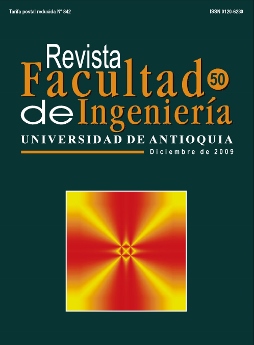Assesment of the influence of copper and nickel on the corrosion kinetics of weathering steels by in situ and ex situ impedance spectroscopy
DOI:
https://doi.org/10.17533/udea.redin.14928Keywords:
Cebelcor, equivalent circuit of Warburg, rust, weathering steelAbstract
A Cebelcor chamber was used to make immersion-emersion cyclical tests of two commercial steels (ASTM A36 and ASTM A242) and three experimental plasma arc melted steels (0.50% Ni, 0.50% Cu and 0.25% Cu+0.25%Ni). Four samples of each steel material were evaluated. Aerated 10-3 M Na2
SO4 solution was employed as corrosive solution. The behaviour of each test was evaluated by means of electrochemical impedance spectroscopy technique (EIS) in situ (inside the Cebelcor chamber) for 1, 15, 30, 45, 60, and 90 days by using a frequency range between 200 Hz-0.01 Hz frequency range. At the end of the exposition the rusts were evaluated outside the Cebelcor by means of the (ex situ) EIS, but using a wide frecuency range (900 kHz-0.005Hz). The simulation of these last data by means of an equivalent circuit with Warburg diffusion impedance, showed the existence of two layers of rust, electrically different between them. The results of in situ and ex situ EIS data for 90 days exposition times indicated that exists a statistically significative difference between the ASTM A36 and the other materials, demonstrating a larger ohmic resistance of the rust of the last ones. The ASTM A36 steel showed that the rust is composed of α/γ FeOOH plus magnetite (10%). The ASTM A242 and the experimental steels with nickel, copper and combinations of
both showed that the rusts are composed of α/γ FeOOH with no evidence of magnetite. A similar effect between copper and nickel in the atmospheric corrosion kinetics was found. All the parameters found in the simulation are interpreted in terms of a phenomenological model proposed for explaining the results.
Downloads
References
J. B. Horton “The rusting of low alloy steel in the atmosphere”. Pittsburgh Regional Technical Meeting of the American Iron and Steel Institute. Washington. 1965. pp. 1-24.
L. M. Ocampo. “Influência dos elementos de liga na corrosão de aços patináveis”. Tese de doutorado. Coppe/UFRJ. Río de Janeiro. 2005. pp. 145.
L. R. M. Miranda. “Les aspects électrochimiques de la corrosion atmosphérique des aciers patinables”. Rapports Techniques. Cebelcor. RT221. 1974. pp. 125.
C. E. Arroyave. “Estudo do processo de formação da ferrugem em atmosferas marinhas”. Tese M.Sc. Coppe/ pemm/UFRJ. Rio de Janeiro. 1988. pp. 215.
S. J. Oh, D.C. Cook, J. Kwon. “Studying the atmospheric corrosion behaviour of weathering steels at a mild marine environment”. Hyper. Inter. Vol. C4. 1999. pp. 49-54.
E. Baena, A. Zuleta. “Estudio de la composición, distribución y morfología de la herrumbre de tres aceros de baja aleación luego de un ensayo acelerado de corrosión”. Trabajo de grado. Univ.de Antioquia. 2005. pp. 121.
S. Hoerlé, F. Mazaudier, Ph. Dillmann, G. Santarini. “Advances in understanding atmospheric corrosion of iron. part II”. Corr. Sci. Vol. 46. 2004. pp. 1431-1465. DOI: https://doi.org/10.1016/j.corsci.2003.09.028
A. Echavarría. “Evaluación electroquímica de cuatro materiales de uso odontológico”. Tesis de Maestría. Universidad de Antioquia. 2000.
M. Keddam, O.R Mattos, H. Takenouti. “Reaction model for iron dissolution studied by electrode impedance”. J. Electrochem. Soc. Vol. 117. 1981. p.p. 147-153. DOI: https://doi.org/10.1002/chin.198123029
E. Barsoukov, J. Ross Macdonald. “Impedance Spectroscopy Theory, experiment and applications”, 2a ed. Ed. Wiley-Interscience John Wiley and Sons. New Jersey. 2005. pp. 101. DOI: https://doi.org/10.1002/0471716243
J. J. Newmann. “Resistance for Flow of Current to a Disk”, J. electrochem. soc. Vol. 113. pp.501-502. DOI: https://doi.org/10.1149/1.2424003
J. Souza, O. R. Mattos, L. Sathler, H. Takenouti,. “Impedance measurements of corroding mild steel in an automotive fuel ethanol with and without inhibitor in a two and three electrode cell”. Corr. Sci. Vol. 27. 1987. pp. 1351-1364. DOI: https://doi.org/10.1016/0010-938X(87)90130-2
D. Vladikova, G. Raikova, Z. Stoynov . “Differential impedance analysis of solid oxide materials”. Solid State Ionics. Vol. 176. 2005. pp. 2005-2009. DOI: https://doi.org/10.1016/j.ssi.2004.12.014
A. Bard and L. Faulkner. Electrochemical methods. Fundamentals and Applications. 2a ed. John Wiley & Sons. New York. 2001. pp.368-416.
L. Van Vlack. “Propriedades dos materiales ceramicos”. Ed. Edgar Blucher. Sao Paulo. Brasil. 1973. pp. 174.
K. García, J. M. Greneche, A. Morales, C. Barrero. “Lost iron and iron converted into rust in steels submitted to dry/wet corrosion process”. Corr. Sci. Vol. 50. 2008. pp. 763-772. DOI: https://doi.org/10.1016/j.corsci.2007.09.003
Downloads
Published
How to Cite
Issue
Section
License
Copyright (c) 2018 Revista Facultad de Ingeniería

This work is licensed under a Creative Commons Attribution-NonCommercial-ShareAlike 4.0 International License.
Revista Facultad de Ingeniería, Universidad de Antioquia is licensed under the Creative Commons Attribution BY-NC-SA 4.0 license. https://creativecommons.org/licenses/by-nc-sa/4.0/deed.en
You are free to:
Share — copy and redistribute the material in any medium or format
Adapt — remix, transform, and build upon the material
Under the following terms:
Attribution — You must give appropriate credit, provide a link to the license, and indicate if changes were made. You may do so in any reasonable manner, but not in any way that suggests the licensor endorses you or your use.
NonCommercial — You may not use the material for commercial purposes.
ShareAlike — If you remix, transform, or build upon the material, you must distribute your contributions under the same license as the original.
The material published in the journal can be distributed, copied and exhibited by third parties if the respective credits are given to the journal. No commercial benefit can be obtained and derivative works must be under the same license terms as the original work.










 Twitter
Twitter